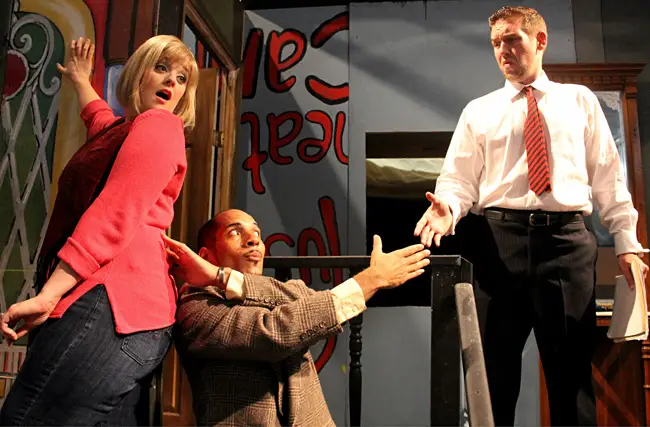
Bruce Popielarski as Paul Bratter. (© Flagler Playhouse)
Note: For tickets to the play, click here.
“Barefoot in the Park,” the 1963 Neil Simon classic that inspired many of today’s romantic comedies, is an appropriate choice as an opener for the Flagler Playhouse’s 2014-2015 season. The production, which opened October 3, tells the story of a young couple who have just moved into their first New York brownstone apartment. The theme mirrors the recent developments at the playhouse itself. The theater company is in its same digs, but it just underwent renovations that weren’t exactly expected, says Playhouse President Pat Love. They were the result of a facilities grant from the state’s division of cultural affairs.
“Barefoot in the Park” starts the season also because of the complex set. The company needed the summer to create it all: a cat walk and skylight to foster the illusion that will transform a vacant apartment into to a fully furnished one, all before the audience’s eyes. “It was quite the dance between the construction of our new addition and the construction of the set,” Love says.
The state money, a $300,000 matching grant award (netting the playhouse $150,000 in matching funds), was a surprise because this type of grant is allocated only every few years, when the state has extra money available. “I think the people who’ve come to our stage will be amazed at what we’ve been able to do,” Love says, “and—new people coming in to see—they think they’re coming into this small little church and they see this elaborate stage, I think will be very impressed as well.
The playhouse wasn’t the only cultural organization to benefit. The Palm Coast Arts Foundation also received a facilities grant of the same value.
Denise Calderwood, the grant writer who is also running for county commissioner, says Florida has been supportive of the arts. The facilities grant can be for as much as $1.5 million, she says. However, because of the economy, the state hadn’t funded one for seven years. Consequently, apathy set in for many state organizations that had given up trying to procure one, which left the door open. Calderwood jumped at the opportunity. “The timing was perfect, with the governor’s election coming up,” she says.
The fact that the playhouse is a firmly established entity, with assets worth $1.2 million, worked in its favor (despite it not getting a letter of support from county government, which was odd considering the county’s renewed focus on the arts as an economic generator), which made it easier to pull in money to expand its existing programming, compared with an organization just getting off the ground.
Now the whole west side of the playhouse building has been extended. To start, the company now has storage facilities for set pieces and a large construction room. “In the past, we had to roll a saw outside in order to build,” Love says. “As you can imagine, when it rained or it was inclement weather, it kind of held up our whole project. Our set builders over the years have been enormously patient and flexible in being able to do that and now they’ll have a much larger space.”
The stage now enjoys additional wing space that, in effect, extends it to the set building area. That way, set pieces can be rolled directly on stage. “That’ll ultimately have a huge impact on the type of shows we can put on,” Love says, “and the complication of the set, the ease of getting set pieces on and off the stage, giving us some wing space. This one renovation will just impact on so many things, not only on the set itself, but for the comfort of the patrons.”
Comfort, that is, facilitated by the addition of multiple men’s and women’s restrooms located just off of the front lobby. Previously, patrons, many of whom are retirees, had to walk down a passageway alongside the stage to get to the restrooms.
The playhouse also has applied for a second phase of this grant that would allow expansion of the lobby out front, the box office, and some other renovations. The theater has heard back yet. Bunnell developer and builder Mark Langello pieced the renovation together.
The playhouse’s season will follow its usual format and will include, among its five plays, three musicals and a Christmas show to give as many young people as possible their first theater experience as possible (there are 36 children in the cast). The Playhouse will conclude the season with Mel Brooks’s “Young Frankenstein.”
One noted difference this season is the departure of Jaime Irvine, the theater’s education coordinator, whom the playhouse had previously secured with another grant from the Florida Division of Cultural Affairs. That grant ran out in July. However, the programming she instituted remains. Only now it will be conducted on a volunteer basis, and the playhouse is now looking for instructional artists: actors, voice teachers, dance teachers, and so on.
The Playhouse is also planning an after-school program in January and in November there’ll be some free staged readings. Playhouse organizers are also in the process this season of trying to put on a staged reading of some original work, and they’re continuing to rent out space and make other accommodations for local artists. The theater is planning more full productions for children over the summer.




























Leave a Reply